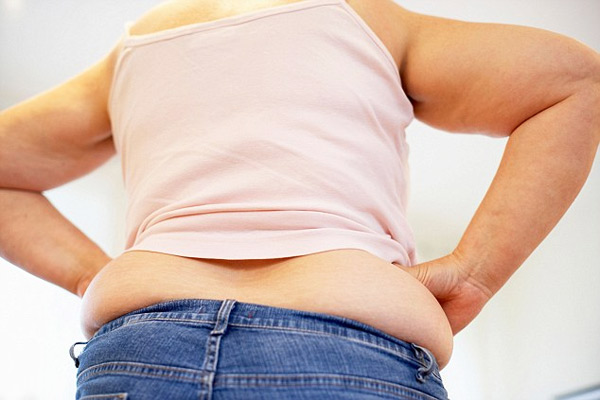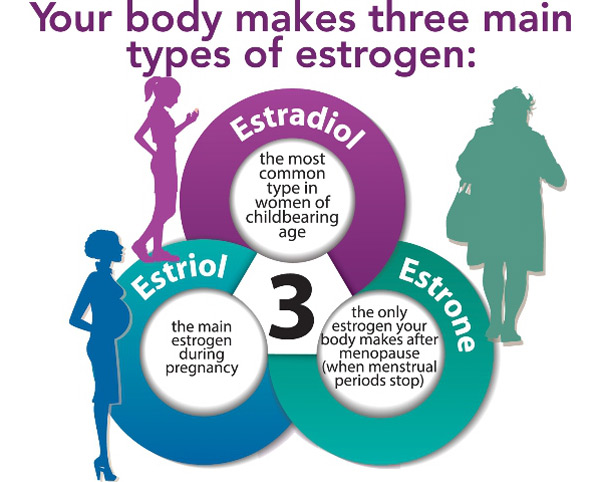
Nearly five per cent of all cancers in women aged 50 – 64 were connected to obesity.
The World Cancer Research Fund found a link to obesity in six types of cancers. Women who were overweight were four times more likely to develop cancer of the uterine lining while obesity boosts the risk by six-fold. Obese women also are at greater risk of breast and colon cancer. Excess weight also increases mortality from many cancers, with the strongest association seen for endometrial cancer; heavy women are 6.25 times more likely to die from the disease.
Several studies have shown that obese people have high levels of toxins stored in their fatty tissue. For example, plastic bottles and containers exude dozens of chemicals. Many of these chemicals, for example bisphenol A and phthalates, are xenoestrogens.
Excess adiposity, or fatness, is the source of many metabolic problems. Obesity is a major cause of liver problems such as non-alcoholic fatty liver. The liver is responsible for over 500 different metabolic functions, so having a liver that is clogged and congested with fat can have health effects that reverberate through the entire body, causing chaos and disorder at every level. For example, the liver is responsible for removing the reproductive hormones from the bloodstream after ovulation. During days 14-28, the uterus, breasts, and other reproductive tissues prepare for the next menstruation. At this time they require an environment that is very low in estrogens and progesterone. When the liver is congested due to toxins and excess fat, it fails to perform its duties, and the blood remains rich with estrogens and progesterone. The female hormones are actually toxic to the other tissues during the final days of the menstrual cycle. That toxicity is experienced as breast tenderness, pain, cramping, emotional lability, and other symptoms that we would identify as PMS.

Most people think that “estrogen” refers to a specific compound. In reality, there is no single chemical compound called “estrogen,” rather the word estrogen refers to a class of related compounds. One form of estrogen commonly known as estradiol has protective effects on women’s bodies. Women with greater levels of estradiol compared to other estrogen compounds show decreased risk of reproductive tissue cancers. Another form of estrogen known as estrone is associated with increased risk for reproductive tissue cancers including breast cancer and others. Obese women produce more estrone, and are also at greater risk for PMS. The evidence of the links of the unholy triad continues to mount.
There is a worldwide trend of girls experiencing puberty earlier than ever. Epidemiology shows us that childhood obesity is a probable cause of early-onset or “precocious” puberty, defined as prior to age 11. Research has shown a link to diet because unhealthy eating patterns cause elevated insulin levels, in itself a risk factors for cancer.
There are many suspected links between xenoestrogens and precocious puberty. Children today are fatter today than in years past, just as their parents and other adults are. Likewise, the bodies of young girls contain more xenoestrogens from plastics, pesticides and other industrial sources. One theory states that these xenoestrogenic compounds act as signals to the developing endocrine system, helping to trigger an early puberty.
When a person accumulates body fat of an amount equal to more than about 20 lbs over ideal weight, the fatty tissues begins to act like a separate endocrine organ, secreting leptin, cortisol, and other non-beneficial hormones. These hormones accelerate the fat-storage process, and through the catabolic, or muscle-wasting effects of cortisol, the body fat begins to take away the muscle stores while piling on the extra fat pounds. This is a run-away train that is very difficult to stop.

The take-home message is clearly spelled out through the research: you can lower your cancer risk by losing weight. You can lose weight by detoxifying. You can lose toxicity by losing weight. At a deeper and more holistic level, you can process and release old tensions, conflicts, and traumas through a variety of somatic or body therapies, including massage, Feldenkrais, hypnosis, EFT, acupuncture, and many other therapies.
The state of vitality capable of fighting cancer, is characterized by a strong body of appropriate body fat, relatively low levels of stored toxins, and the healthy ability to release old traumas, resulting in a state of lowered disease risk, heightened immunity, strength, confidence and clarity. This vitality state can be achieved systematically through healthy choices in diet, exercise, healthy introspection, and, increasingly relevant for today, detoxification, internal cleanses, and spiritual or mental fasts from media, noise, pollution and negativity.
Note: After smoking, obesity is the biggest risk factor for cancer, and the evidence showing the link continues to strengthen. Small changes can have a big effect on our cancer risk and everyone needs to take action, individuals as well as government.
Disclaimer
The Content is not intended to be a substitute for professional medical advice, diagnosis, or treatment. Always seek the advice of your physician or other qualified health provider with any questions you may have regarding a medical condition.



